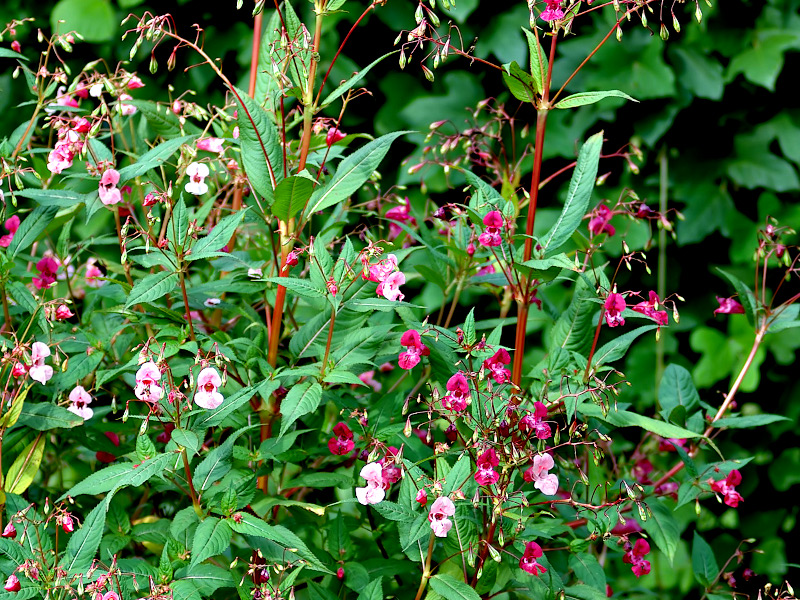Wise Mind Herbs
Evidence-based Herbal Healing
The information on this page has been prepared with reference to published scientific literature, not by a medically qualified expert. It is not medical advice. Any decision to use a supplement or herb-based product is your responsibility. Consult a suitably qualified medical professional, especially if you have underlying conditions. Remember, nothing is for everyone, and not everything sold is what it claims to be. Some things work for some people, some of the time.
Himalayan balsam - Impatiens glandulifera
Himalayan balsam (Impatiens glandulifera) is an annual plant belonging to the family Balsaminaceae. It is also commonly known as Indian balsam, policeman's helmet, Bobby tops, and touch-me-not. This plant should not be confused with other Impatiens species such as Impatiens balsamina (garden balsam), Impatiens noli-tangere (yellow balsam), or Impatiens capensis (orange balsam), which have different phytochemical profiles and potential health effects.

Image source and license: https://commons.wikimedia.org/wiki/File:Impatiens_glandulifera_-_plants_%28aka%29.jpg.
Modified by Peter Jorgensen.
Scientific Evidence for Health Benefits
It is important to note that despite traditional uses in some cultures, Himalayan balsam has limited scientific research supporting its medicinal properties. Most peer-reviewed studies focus on its invasive ecological impact rather than therapeutic potential. The plant is considered a noxious invasive species in many regions including Europe and North America.
The limited research available suggests potential anti-inflammatory, antioxidant, and antimicrobial properties in vitro, but clinical evidence for treating specific health conditions in humans is largely absent. No meta-analyses on the therapeutic effects of Himalayan balsam were identified in the literature from 2020-2024.
Conditions with Limited Evidence of Benefit
- Minor skin inflammations (topical use only)
- Mild digestive discomfort (traditional use)
- Wound healing (preliminary in vitro evidence only)
Bioactive Compounds
Research has identified several compounds in Impatiens glandulifera including:
- Naphthoquinones (including 2-methoxy-1,4-naphthoquinone)
- Flavonoids
- Phenolic acids
- Essential oils (including terpenes)
Dosage Information
No standardized dosages exist due to insufficient clinical studies. Traditional applications have used:
- Topical preparations: Fresh plant juice or infused oils applied externally
- Oral consumption: Occasional use of young shoots or flowers in salads (not for medicinal purposes)
No standardized extracts with consistent amounts of active compounds have been established in the scientific literature. The lack of standardization makes reliable dosing recommendations impossible.
Side Effects and Contraindications
- Potential for allergic reactions, especially in individuals with known sensitivity to plants in the Balsaminaceae family
- Possible gastrointestinal discomfort with internal use
- Contraindicated during pregnancy and lactation due to lack of safety data
- Possible interactions with medications (unstudied)
Environmental Concerns
Himalayan balsam is classified as an invasive species in multiple countries. Its aggressive growth and spread can negatively impact biodiversity and native ecosystems. Cultivation for medicinal purposes is discouraged or illegal in many regions.
Commercial Pharmaceutical Products
Currently, there are no approved pharmaceutical medications containing Himalayan balsam extracts or compounds. Unlike some other medicinal plants that have led to drug development, Impatiens glandulifera has not been developed into standardized pharmaceutical products.
Research Gaps
Significant knowledge gaps exist regarding:
- Effective therapeutic dosages for any condition
- Long-term safety profile
- Drug interactions
- Standardized extraction methods
- Clinical efficacy for any health condition
- Comparative efficacy against standard treatments
Studies exploring dosage ranges above traditional uses have not been conducted. No maximum efficacious range has been established in the scientific literature, representing a substantial research gap.
Conclusion
Despite some traditional uses, the scientific evidence supporting health benefits of Himalayan balsam is preliminary and insufficient to make specific therapeutic recommendations. Its status as an invasive species further complicates its potential medicinal development. More rigorous research, including controlled clinical trials, would be needed to establish any legitimate medicinal applications.
References
Cimmino, A., Mathieu, V., Evidente, M., Ferderin, M., Banuls, L. M. Y., Masi, M., ... & Evidente, A. (2016). Glanduliferins A and B, two new glucosylated steroids from Impatiens glandulifera, with in vitro growth inhibitory activity in human cancer cells. Fitoterapia, 109, 138-145.
Delgado-Rodríguez, F. V., Weng-Huang, N. T., Loría Gutiérrez, A., Arias-Núñez, D., & Rosales-Leiva, C. (2023). Ethnobotany, Pharmacology and Major Bioactive Metabolites from Impatiens Genus Plants and their Related Applications. Pharmacognosy Reviews, 17(34).
Ruckli, R., Hesse, K., Glauser, G., Rusterholz, H.P. and Baur, B., 2014. Inhibitory potential of naphthoquinones leached from leaves and exuded from roots of the invasive plant Impatiens glandulifera. Journal of Chemical Ecology, 40, pp.371-378.
Singh, P., Singh, R., Sati, N., Ahluwalia, V., & Sati, O. P. (2017). Phytochemical and pharmacological significance of genus: Impatiens. Int. J. Life. Sci. Scienti. Res, 3(1), 868-881.
Szewczyk, K., Kalemba, D., Komsta, Ł., & Nowak, R. (2016). Comparison of the essential oil composition of selected Impatiens species and its antioxidant activities. Molecules, 21(9), 1162.